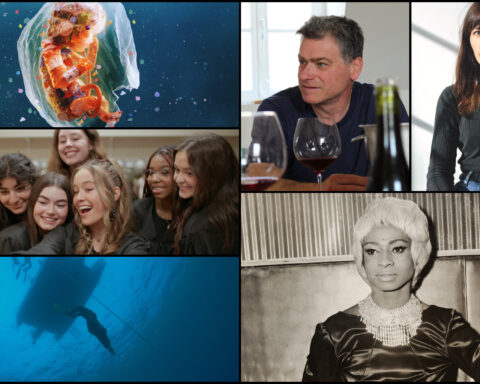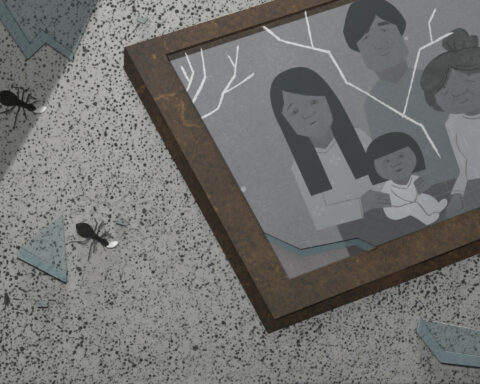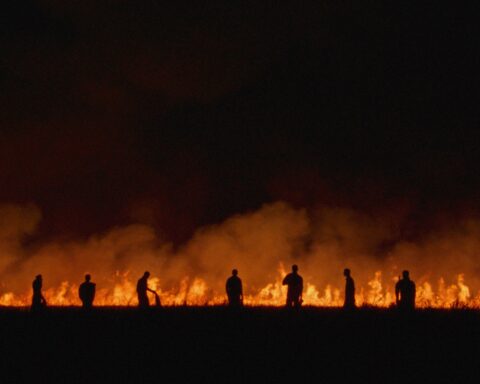The weight of Canada’s sesquicentennial is being felt across a range of cultural manifestations and CONTACT, Toronto’s month-long photo festival, is no exception. The 20 primary exhibitions and 17 public installations all spotlight Canadian artists, as well as most of the 40 featured shows. “We did think about the anniversary when we were putting together this year’s edition,” recognises Bonnie Rubenstein, the event’s artistic director. “But it’s not a 150 celebration per se. Our focus is Canada, period.”
Accordingly, Rubenstein, along with many of her colleagues across the city representing a number of partnering organisations, felt that the programming had to embrace a broad range of perspectives. “We had to make sure that different stories and different sides of these stories were being highlighted,” she says. This concern raises an interesting question about the country’s photography landscape: Is it as diverse as Canadian society?
This question brings up a series of related interrogations. How do you measure diversity? Where does diversity lie: in the cultural and social make-up of the artists, in the genres and practices they explore and espouse, or in who appears in photographs and how they are represented? It would be preposterous to think that there are any definitive answers to these questions. But this spring’s exhibitions in Toronto, and elsewhere across Canada, make good fodder for discussion. For example, the newly minted Canadian Photography Institute at the National Gallery of Canada in Ottawa is presenting Photography in Canada: 1960-2000, which invites museum-goers to “experience the diversity of Canadian photographic practice and production from 1960 to 2000.”
“Photography has always been a medium used by a multitude of people since it is perceived as easier and more accessible than other art practices,” remarks Gaëlle Morel, the exhibitions curator at the Ryerson Image Center (RIC). Hailing from France, but having worked in Canada for nine years, she believes that photography is as diverse here as anywhere else, in terms of artistic practices. The festival’s 2017 programming is very much a testament to that notion.
“The diversity of approaches that we see is phenomenal,” notes Darcy Killeen, the executive director of CONTACT. “This year, we have moving image creations of various length, sculptures, neon works that reside on top of pictures, old and new analog images, digital pieces, etc. Technology is one of the major drivers of that diversity. Everyone has a camera in their back pockets, so everyone is pushing the boundaries in every way. They all play off of each other to continue to expand the realm of what is possible with the medium.”
Compare for instance the styles of Petra Collins and Robert Burley, two of this year’s stars. The first, a 24-year-old from Toronto now living in New York City, is a fashion darling. She’s been shooting editorials for the likes of Glamour, Vogue, Jalouse, Purple Magazine and CR, as well as commercials for Gucci Eyewear, Nordstrom, Adidas, Urban Outfitters, Calvin Klein and others. Her images, often described as dreamy, ethereal and hyper-feminine, marry vintage aesthetics with contemporary concerns, especially the culture of young women who are shown as nuanced beings exploring their boundaries and defining their selves in the process.
The only apparent link between Collins and Burley, whose work is on view at John B. Aird Gallery, seems to be their focus on what is close to them. “I find it difficult to go to places that I’m unfamiliar with and make anything that’s meaningful. I tend to stay close to home. I’m very interested in the built environment. Toronto is a natural subject for me,” explains the 60-year-old photographer. He spent the past four years exploring the 230 square kilometres—“about the size of 30 Central Parks”—of green spaces that make up the city’s parklands system. His photos of the lake’s shoreline, the river valleys, the creeks and the forests reveal our ambiguous relationship with nature. The vistas are awe-inspiring, while the few human figures dotting the landscapes appear as mere specks. This topic, given the nation’s expansive wilderness, seems like an obvious one for Canadian lens-based artists. Yet Burley feels like “there could be so many more projects looking at this country. We’re living at a time when Canadians are looking at their home with new eyes and when the rest of the world is looking at us in a variety of ways.”
“CONTACT has always been a very diverse festival,” believes Stephen Bulger, one of the event’s instigators, who currently sits on the advisory board. “Part of [the reason for this] is the democratic nature of how it was set up with the different tiers.” The “primary” tier is reserved for large exhibitions created in partnership with the festival; “featured” is affixed to a selected few culled from the submissions of commercial or not-for-profit galleries; and everything else qualifies as “open.” Thanks to this system, the event now boasts 200 exhibitions in total.
That said, for all its openness, the event can prove inaccessible to some. “People still have to get over a number of hurdles. These include securing a location, affording the printing, matting and framing of pieces and paying a registration fee of a few hundred dollars. As a result, we have no choice but to admit that there’s a lot more diversity in the Canadian population than in the exhibitions,” explains Bulger. Let’s not forget that one needs to have the space, the time and the resources to create works.
Shelley Niro, a Mohawk artist, remembers how her approach evolved from limited means: “I took a photography course at Durham College in 1977 as part of the graphic arts curriculum. I eventually dropped out of that programme, but kept photographing. At the time, I could only afford to make black-and-white images. I started to hand-colour them and thinking of other ways to push what I had to make them more exciting.” These methods also included collages, hand-drawing embellishments and a dose of humour. She focused her lens on her family, friends and community.
“I was just being myself and it seemed like nobody else was doing it,” Niro recalls. “I started thinking about who was representing whom. Back then Native people were not represented by Native people, so I thought this was an opportunity for me.” Through the years she continued to experiment with different mediums, such as painting and film, inserting Indigenous history into the North American art world. And, as time wore on, she noted that more Indigenous photographers emerged thanks in part to the advent of cheaper technologies.
“It comes down to financial. When I started doing photography, the economy was such that I had to be very deliberate. Now there’s more space to play,” Niro remarks. Battlefields of My Ancestors, a recent series, will be installed on the Ryerson campus, flanking the statue of Egerton Ryerson—whose ideas were used as blueprints for the residential school system—as well as at Fort York. They depict the grounds that are of significance to her kin, situated on both sides of the border. Cherry Valley was a site attacked by Loyalist soldiers, as well as Seneca and Mohawk warriors, during the American Revolutionary War. As retaliation, General George Washington ordered “the total destruction and devastation of their [the tribes of the Six Nations] settlements, and the capture of as many prisoners of every age and sex as possible.” The village of Gar-Non-De-Yo was amongst those destroyed during the campaign. By focusing attention on places that most have forgotten, Niro is compelling us to read up on events too often obscured.
Similarly, curator Julie Crooks has approached this year’s fixation with the nation as an opportunity to address some glaring historical voids and reflect on why, in regards to the Black community, Canadian photography is not as diverse as it could be. The two shows she organised, “Free Black North” at the AGO and “Ears, Eyes, Voice: Black Canadian Photo-Journalists 1970s-1990s” at the BAND Gallery, fill some of the gaps. The former features tintype portraits of Black Canadians living in southern Ontario made in the mid-to-late 19th century, and speaks to how these men, women and children reclaimed the medium once used to dehumanise them. The latter, as the title suggests, highlights the work of Black documentarians who worked for national mainstream newspapers and local community presses. Here, the contrast with our southern neighbour is telling.
While many of us are able to name African-American photographers — Gordon Parks, Carrie Mae Weems, Roy DeCarava, among others — we might be hard-pressed to do the same at home. “We have yet to recognise the contribution of the likes of Jules Elder, Eddie Grant, Diane Liverpool, Al Peabody and Jim Russell,” says Crooks. She feels that we haven’t been doing our homework: “If you want to know, you can find out. It’s a matter of asking questions, doing research, looking into the archives.” Institutions and individuals alike have to do their part in challenging the dominant discourse. She also hopes that, with curators giving prominence to previously under-recognised works, the current generation of artists of colour will gain role models and a sense of community, which, she notes, has been lacking in Canadian photography compared to the United States. The idea, in a way, is to create a critical mass to force open the doors of esteemed establishments. “If you don’t have the network and the personal connections, you will always be on the periphery,” adds Crooks, who urges galleries, media outlets and other organisations to be more inclusive in their hiring practices, operations and mandates as well as their programming.
“We’re trying to go against our own instincts and our tendency to reproduce the system as we know it,” says Morel, who has worked with Crooks on some of the RIC’s programming. “We do our best to open our spaces to visible and invisible minorities, to create a diversity of opportunities and to be critical of ourselves and our society. I always thought that being part of a university gave us the obligation to resist the urge to sweep difficult stories under the rug.”
During CONTACT, while the main gallery space is dedicated to Suzy Lake, the Scotiabank Photography Award winner, the media wall is screening “Souvenir,” four short films made by Indigenous artists. Using material from the National Film Board of Canada’s archives, they reinterpret our official history.
Yet all the effort being made this year to highlight critical oeuvres by artists embodying different perspectives and employing different tools will amount to little if it is not sustained. “With the 150th anniversary, curators have been looking for Indigenous works like never before. That’s great. But let’s remember that Indigenous artists produce pieces year-round and that those deserve to be shown day in, day out,” exhorts Niro. The same is true for all other communities of artists who contribute, whether in the limelight or in the shadows, to the richness of Canadian photography.











